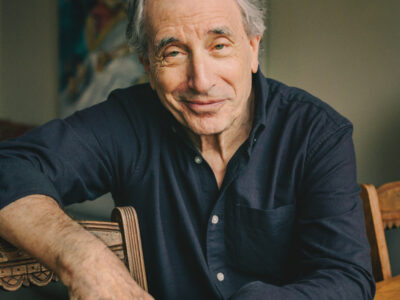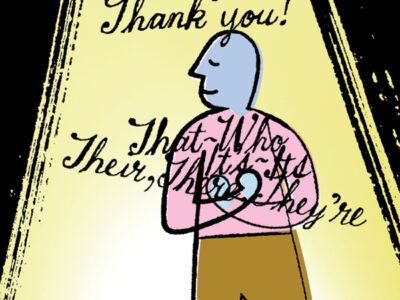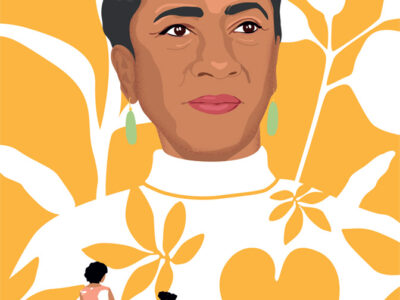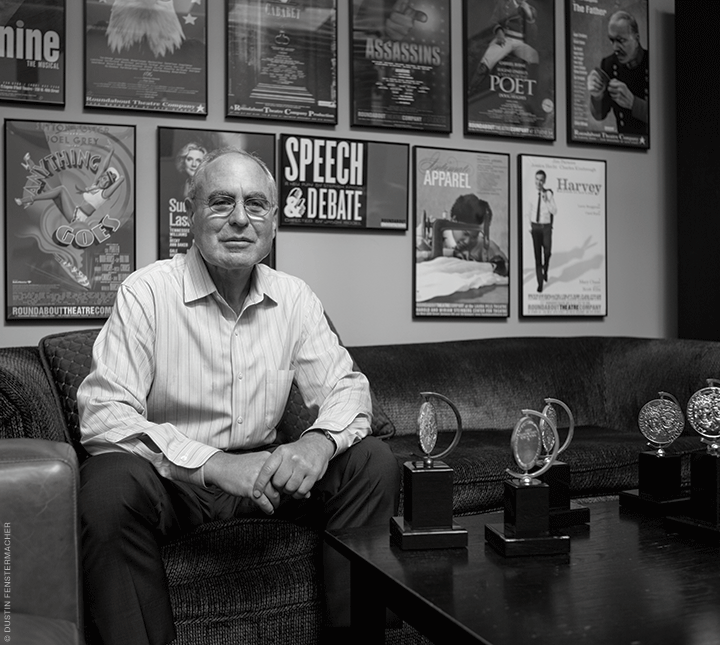
Todd Haimes has the career he dreamed about and sits at the top of his field. When can he stop worrying?
BY MOLLY PETRILLA | Photo by Dustin Fenstermacher
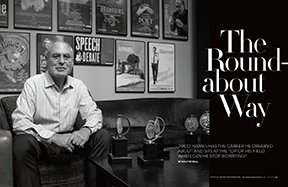
Todd Haimes C’78 had a new Great American Musical series but no musical.
He had a revival of Cabaret to announce but suddenly no Emma Stone to star in it.
He had a potential smash on his hands but no theater to put it in; an actor and a director who couldn’t stand each other; a hit show but a scaffolding accident that closed it down.
Think of any show-must-go-on moment, and Haimes has probably faced it as artistic director of the Roundabout Theater Company. Maybe that’s why he worries so much.
He’s been at it since 1983, when he started to drag the faltering theater out of Chapter 11 bankruptcy and transform it into a not-for-profit powerhouse. Yet even today, with Roundabout celebrating 50 years and the biggest budget in the business, with 29 Tony Awards and five theaters, Haimes still doesn’t feel like the trek is over and that it’s safe to throw off his pack and sit down for a while.
“I still spend my life worrying,” he says. “My worries are different now—I don’t worry about going out of business—but there’s the pressure of running a $50 million institution and having 200 staff members depending on me and putting together a season and getting stars to work for no money and…”
He can go on like that for a while. As the final yes or no on all things Roundabout, everything stops at Haimes. Choose the wrong musical and the theater can lose millions of dollars. Buy another venue and audiences may not fill it. Land a superstar cast and The New York Times might still slam the show.
Even when there’s good news—another Tony or a gushing review—“he tends to feel Roundabout’s successes serve only to heighten expectations going forward,” says Vicki Reiss C’77, Haimes’s close friend and the executive director of The Shubert Foundation, which awarded $24 million to not-for-profit theatres and dance companies last year.
“All things considered,” she adds, “Todd will probably go the road of worry rather than allowing himself to indulge in too many relaxed moments of pleasure.”
Yet for all his personal worrying, Haimes is the one who calms the artists and creatives who surround him. He’s the one who bandages scraped egos and encourages first-time directors, who gives Tony acceptance speeches even though public speaking terrifies him, who visits an upset star’s dressing room and smoothes things over.
His office is tucked inside the Roundabout’s 12th-floor labyrinth in Times Square. There’s a sink in the corner, a snow-globe collection on his desk, and very few hints that he’s produced some of the biggest Broadway revivals and star-making performances: Cabaret in 1998 with an unknown Alan Cumming and famous Natasha Richardson; Nine with Antonio Banderas and Jane Krakowski; Assassins in 2004 with a nearly forgotten TV actor named Neil Patrick Harris.
Every day Haimes enters that office, perched high above the theaters he runs. He has the job he’s wanted since college, he’s considered one of the best in his field—so when can he stop worrying?
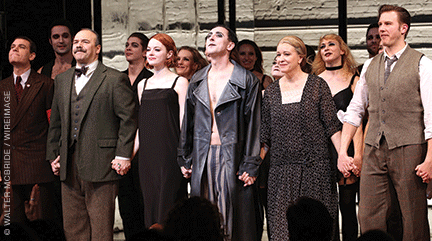
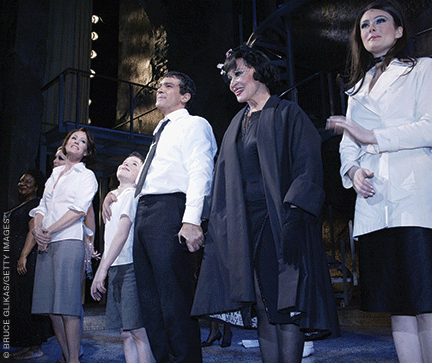
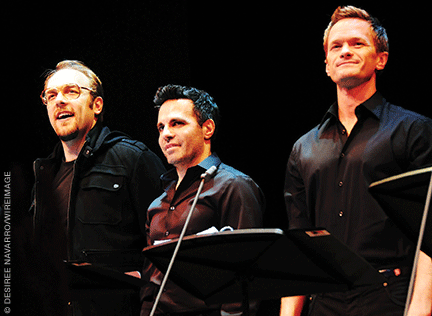
Haimes was 26 years old when he heard about the Roundabout job.
Back then it was a small off-Broadway theater that produced five classic plays each season: Shaw, Ibsen, Chekhov, Shakespeare. It also had “the absolute worst reputation in the business,” he says. “It was run by two guys named [Gene] Feist and [Michael] Fried, and even before working there I knew they were referred to as Heist and Greed.”
But he was desperate to land a job in New York City. His wife had her medical internship there, and he was sick of commuting to Connecticut, where he’d been managing another strapped theater.
He went in for an interview and discovered that Roundabout was in bankruptcy and owed thousands in unpaid taxes. “I thought to myself, ‘Well, I’m 26 years old, I don’t have any kids yet, I have to stay in New York, what the hell. I’ll try it.’ So I took the job,” he says. He replaced Fried as the theater’s managing director.
Two months into his new gig, it looked like the show was already over. The theater was so cash-strapped that it couldn’t meet payroll. A few hours after his mother’s funeral, Haimes went to a Roundabout board meeting. They voted to close the theater.
Two board members went home to write a press release, “and I went home to be extremely depressed,” he says.
Then his phone rang the next morning. A board member had produced the $150,000 that Roundabout needed to put on its next show. No need for that press release—the theater wasn’t closing after all.
“After that,” Haimes says rather proudly, “the theater never lost money again for 20 years.
“There are two kinds of businesses that are in trouble: businesses that are going concerns that are terribly mismanaged, and businesses that just aren’t going concerns,” he adds. “It turns out, luckily, that Roundabout was a terribly mismanaged going concern. When I fired everybody and managed it properly, it actually started making money.”
Reiss came in as director of development in 1985, after Haimes had cleaned house. She remembers making calls with him, trying to recruit new board members, and how “fabulously blunt” he was: Here’s what happened. Yes, it was terrible. Yes, so-and-so should probably be in jail, but he’s not. This is our budget. This is our deficit. But we have a great artistic product.
“He never tried to cover up the negative aspects,” Reiss says. “It was a very unique approach and it taught me something about appreciating those who are completely forthcoming.”
Haimes curls into a large leather chair in his office as he remembers those early days. Now he’s weeks away from launching Roundabout’s 50th season, which will include shows with Keira Knightley, Clive Owen, and Jessica Lange. He brought Roundabout to Broadway in 1991 with a new theater, and the not-for-profit now runs four venues—with five theaters total—spread across Manhattan. On top of classics, it produces musicals and contemporary plays too.
“He’s made a giant presence of the Roundabout in New York between the number of theaters that he’s created and the amount of work that he’s done,” says Lynne Meadow, artistic director of the prominent not-for-profit Manhattan Theater Club since 1972. “He’s one of the great producers working in New York today.”
But about an hour and a half into our conversation, that great producer says he wants to puke.
He’s still lounging in the big brown chair, gripping a can of Diet Coke. Was it bad sushi at lunch? Is the interview taking too long? No, nothing like that. He’s just sick of talking about himself. “It’s bothering me,” he says.
Haimes is usually the one asking questions. Reiss says it’s “kind of like pulling teeth to get him to talk about himself.”
Chris Yegen, chairman emeritus of the Roundabout board, describes his friend’s gift for sliding the focus of any conversation to the person across from him.
Even if you start out by asking Haimes about himself, soon “he’s finding out what you’re happy about, what you’re unhappy about, what your mother’s happy about,” Yegen says. “It’s subtle enough that you don’t even realize it’s happening.”
He says it’s the same whether Haimes is chatting with an old friend or a celebrity. “You walk away feeling like this is a person who’s really interested in me and I really enjoyed having this conversation. Now I want to help him, I want to work with him, I want to do what he wants me to do.”
In 1992, a year after Haimes moved the Roundabout to Broadway, a young British actress came to see him.
She had done a production of Anna Christie in England and wanted to bring it stateside. Lincoln Center and Circle in the Square Theatre had both turned her down already. Roundabout was Natasha Richardson’s last shot.
After Haimes agreed to do the show, Richardson came back with another request. Could an unknown actor named Liam Neeson star in it with her? Sure, Haimes said. Go for it.
“I remember getting a telegram saying ‘Liam Neeson accepts your offer,’ and I thought to myself, ‘Well, that’s nice,’” he says now.
“It turned out to be the sexiest production of Anna Christie in the history of [Eugene] O’Neill and the biggest hit in New York that year,” he adds. “It put us on the map”—and landed Roundabout’s first Tony Award.
Haimes had a lot to prove back then. He’d become Roundabout’s artistic director three years earlier, in 1989. “At that time, it was almost considered heresy to go from management to artistic in the not-for-profit theatre world,” he says.
Other ADs thought it was absurd and directors didn’t want to work with him. He had an MBA from Yale, but what did he know about picking the right shows or making sure they looked good? He’d never directed a play, never even acted in one.
It was bumpy at first, he admits. “I learned on the job and made a lot of artistic misjudgments.” He put on four somber plays his first year and subscribers wrote letters asking if he was depressed.
But then came Anna Christie and, that same season, Roundabout’s first musical, She Loves Me. The momentum continued with the theater’s first Sondheim show in 1995 (Company) and then its hit Cabaret revival in 1998. Roundabout stars became celebrities. Its productions won Tonys.
Ken Davenport, a commercial Broadway producer, says that a track record like Haimes’s doesn’t come from lucky hunches or gut decisions. “It’s a real, deep, innate understanding of how to build a business,” he says. “And we’re very lucky that the business he chose to build was a great theater company.”
Many of Haimes’s peers relish the opening-night parties and glad-handing. They’re often former actors who still savor the spotlight, not MBA-wielding introverts. Haimes has never wanted to be on stage. The first and last time he acted was in first grade. He played Mary Poppins in his all-boys’ school production. “Horrifying,” he recalls.
The requisite parties and splashy events “are real challenges for me,” he says. “I’m never going to be an extrovert or have an impresario-type personality. That’s just the way it is. I do the best I can, and either people find it charming and accept it, or I guess they don’t.”
He’d rather be in the office, hammering out finances, planning seasons, booking actors two years in advance, and hearing what your mother’s happy about. Even after 26 years as artistic director and dozens of awards speeches, he says public speaking still makes him nervous. Or, in the case of the Tonys, “terrified.”
When he’s not in his office, Haimes spends most of his time shuttling between Roundabout’s five theaters. They’re spread across 12 blocks in Manhattan, bound on either side by Sixth and Eighth avenues.
One day he may catch the final run-through of an upcoming show, then listen to an upset star’s complaints at another production (“If we can’t give them money, we at least have to give them a supportive environment”), then welcome a group of actors and creatives who are starting rehearsals for a third show.
In late August, with the 2015-16 season still a few weeks away, he was doing the latter. Inside a rehearsal space cluttered with tote bags and water bottles, he stood up front, talking to a small group sans notes. (He calls this “speaking from the heart” and prefers it to reading a pre-written speech, even at the Tonys.)
They were preparing for Ugly Lies the Bone—a play that will run in Roundabout’s 62-seat Black Box theater this fall.
Roundabout’s bigger theaters are reserved for hit shows and Tony bait: Cabaret with Alan Cumming in Studio 54; Anything Goes, which won Sutton Foster a Tony, in the Stephen Sondheim Theatre; On the Twentieth Century with Kristin Chenoweth and Peter Gallagher in the American Airlines Theatre. The Black Box is his passion project, despite the fact that each production actually loses money.
About 10 years ago, Haimes noticed that even in Roundabout’s off-Broadway Laura Pels Theater, reviewers treated a young playwright’s first show “as if it were a major Broadway production,” he told the Ugly Lies the Bone group. “It seemed to me terribly, terribly unfair.”
He decided to build a black box theater—named for its no-frills black walls and blank stage—in the basement below the Pels. It opened in 2007 and presents only new works from emerging playwrights. Tickets cost $25.
A few years ago, playwright Joshua Harmon stood where the Ugly Lies writer and cast do now. He had two degrees in playwriting and a third in-progress at Julliard, but his plays had only landed three-day stints on college campuses.
Roundabout put his play, Bad Jews, into the Black Box and Haimes moved it up to the Pels Theatre the next season, where it continued to sell out. Last year it was the third most-produced play in the US.
“You’d think it would be a one-way street of gratitude—they open the door and you feel grateful,” Harmon says of Roundabout. “But I think Todd feels equally grateful to the playwrights who trust the Roundabout with their work.”
“What I’m trying to say,” Haimes told the Ugly Lies group in August, “is that the Underground—even though it’s a relatively small part of our budget—is a disproportionately large part of the soul and heart of Roundabout. It’s why we all went into theater.”
In his office the next day, he admits that he’d love to spend most of his time in the Underground with young writers and directors. “It’s one of the great joys of my life,” he says. But the Underground is $300,000 of Roundabout’s $50 million budget—and even when its plays sell out, the theater loses $250,000 on each Black Box production.
“It’s complicated to talk about what is fulfilling and exciting and happy and what is successful because they’re almost two separate things,” he says. “Sometimes they come together, but sometimes they don’t.”
When Cabaret sales helped buy Studio 54 and On the Twentieth Century landed five Tony nominations last year, that was exciting and happy, no question. But the Underground recaptures his earliest days at Roundabout, when he brought in Richardson and Neeson for Anna Christie, or when he finally landed a Sondheim show.
And it’s even closer to his days at Penn, where he produced his first show in the Bicentennial summer of 1976.
He formed a not-for-profit called Theatre Pennsylvania that year, threw in some of his own money and raised the rest from friends. It came to a few thousand dollars total—not a lush budget even then, but enough for him to produce You’re A Good Man, Charlie Brown in Houston Hall.
Haimes had just finished his sophomore year when he began casting student actors and hired a director. He drew up contracts that outlined the rehearsal schedule (six to seven days a week), the five-week performance run, and the actors’ $25 weekly salary.
“Most of us in that small cast would probably have done it for free, though we didn’t dare tell him that,” says Mark Pfeffer C’77, who played Schroeder and now works as a lawyer. “But Todd, at considerable personal economic risk, gave us the chance to call ourselves professionals.”
Haimes had joined Penn Players as soon as he got to campus. He met his first wife, Alison Bender Haimes C’77 M’81, on the stage crew for Kiss Me, Kate their freshman year. They each held one side of a staircase during the final number.
While the students produced Kate downstairs in the Annenberg Center, a professional theater company had their own show running upstairs. The “real” actors would often slip down and lurk in the wings, watching the students perform.
“That was very exciting to we actors,” says Jed Bernstein C’77, now the president of Lincoln Center for the Performing Arts. But as assistant stage manager, it was Haimes’s job to keep those wings clear of stragglers. “He would chase them all away,” Bernstein recalls. “It completely annoyed the cast.”
“I think he had a maturity that went way beyond his years,” says Reiss, who remembers Haimes roaming campus with a briefcase.
He was an oddity in the student theater world—a non-actor who had no interest in the spotlight. “We were performers who enjoyed the attention,” Pfeffer says. “I now see that Todd did it for a higher purpose: his love of the art form.”
His first commercial production didn’t make Haimes rich. Attendance swung from full houses to nearly empty ones during You’re A Good Man, Charlie Brown’s run. But unlike many Broadway revivals, it ultimately broke even.
It also helped birth his producing style. Pfeffer says Haimes assembled the cast “because he knew we were good choices,” then let them do their thing without meddling. “As a performer, I’ve realized directors or producers want to limit your choices,” he says. “I never saw any of that from him. He left it up to the director and the performers.”
Nearly 40 years later, Haimes still describes his job as “putting the best people together and hoping that magic happens.”
“He just trusts the people he hires,” says Scott Ellis, the associate artistic director at Roundabout who has also directed episodes of 30 Rock, Weeds, and Modern Family. “He’s not someone who hangs around or puts pressure on you. He allows that freedom to happen, and that’s unusual for artistic directors.”
In October 2009, The New York Times’ chief theater critic reviewed Roundabout’s latest revival.
“‘Bye Bye Birdie’ may be the most painful example of misapplied talent on Broadway since the Roundabout’s production of ‘Hedda Gabler,’ starring Mary-Louise Parker, last season,” Ben Brantley wrote.
Last year he called The Real Thing, a Roundabout production starring Ewan McGregor and Maggie Gyllenhaal, “one of those unfortunate revivals that make you wonder if the play in question is worth revisiting.”
He’s praised plenty of Roundabout shows over the years too, but those aren’t the reviews that stand out when you’re worried about the empty houses and lost revenues that can follow a Times pan.
“I think it’s sad that one critic, whoever that critic is—but I’m referring directly to The New York Times now—has so much power, because it’s one man’s aesthetic,” Haimes says. “The movie business isn’t like that. It’s not critically driven. It’s almost the inverse.”
He bristles at a mention of the “theater is in trouble” refrain, though. “I don’t understand the question,” he snaps back. “Broadway has never been healthier. There’s no evidence of anything other than that.”
But he acknowledges that things have changed. Roundabout is down about 12,000 subscribers since 2008. Roughly 70 percent of Broadway ticket-buyers are tourists now, according to data from The Broadway League, compared to 30 percent when Haimes started out—and those tourists want to see blockbusters like Wicked and Book of Mormon, or maybe Bradley Cooper in The Elephant Man and James Franco in Of Mice and Men.
Haimes feels pressure to bring in big stars for his own shows because those names sell tickets. Yet even when celebs are interested, he still has to convince them to plan around Roundabout’s schedule, make sure they’re up to challenging material, and get them to work for $1,300 a week.
He says Roundabout’s reputation helps attract big names, as does its unusual choices. “Nobody is going to do Thérèse Raquin commercially on Broadway, but I think it’s a great play, and so do Keira Knightley and Judith Light,” he says. “That’s how we get them.”
He’s also seen a harsh review or personal conflict unravel stars and turn a backstage “toxic.” That’s when he steps in, “more as therapist than mediator,” he says. “It’s a very emotional business. Very emotional.”
“Sometimes the last thing I want to do is go over to that star’s dressing room and ask how they are,” he adds. “Then I say to myself, ‘If it’s the last thing I want to do, then it’s what I should do.’”
“Todd is what I call an ego absorber,” Yegen says. “He can in effect sublimate his own ego—at some significant cost, I would say—and make anyone feel that what they’re doing for the theater is critical, which in most cases it is.”
He says Haimes can gently convince actors, directors, and writers alike to trust him with their work—and by extension, to trust Roundabout.
Google Haimes and you’ll find him posing with major stars who’ve performed in Roundabout shows: Helen Mirren, Jennifer Garner, Sutton Foster, Sarah Paulson.
Mirren even gushed about him recently. She made her Broadway debut 20 years ago in the Roundabout’s production of A Month in the Country, and the theater honored her at a gala in March.
“If Todd were English, he’d be Sir Todd Haimes,” she said in a speech that night. “In fact, I’m going to dress up as the Queen and knight him myself.”
”The thing about art,” Haimes says, “is it’s art, not science.” Land big stars, snag an amazing director, pick an interesting show, and you could end up with a Tony winner or a belly-slapping flop off the high dive.
Roundabout ended its 2013-14 season with a deficit after its big musical, The Mystery of Edwin Drood, didn’t sell enough tickets.
“I completely freaked out,” he remembers. “We froze salaries, we cut back where we could—although there aren’t a lot of areas to cut back because you have to still do the shows.”
The theater finished last season $9 million ahead. “Everything went right,” he says. He finds that unpredictability “both exhilarating and terrifying,” which is why he launched a $50 million capital campaign, most of which will build up Roundabout’s endowment for the slow years.
“I’m going into next season just as scared as I was at the beginning of last season,” he says. “I still feel enormous pressure in an environment that is more pressure than ever.”
Reiss remembers back to 1998, when Roundabout won Tonys for best revival of a play (A View from the Bridge) and best musical revival ( Cabaret).
A boyish-faced Haimes took the stage both times, less than an hour apart, to collect awards from John Lithgow and Angela Lansbury. He rattled off long thank-you lists (no notes), smiling and composed.
Reiss went out for a celebratory dinner with Haimes and his then-wife Alison soon after, and “he looked so glum,” she remembers. “We had to implore him to smile. He was already on to, Oh no, what is everybody going to expect of us next?”
Four years later, Haimes lay in the hospital, fighting a rare cancer in his jaw. Doctors removed half of his jawbone and replaced it with bone from his calf. Unsure if he’d even make it out of the hospital alive, he began to think about his worrying and pessimism.
He decided it wasn’t worth it. He promised himself that if he survived, he’d stop letting “the stupid little things, like a New York Times review, drive me crazy,” he says.
“That vow lasted about four months.”
Molly Petrilla C’06 is a frequent contributor to the Gazette and the magazine’s arts & culture blogger.


